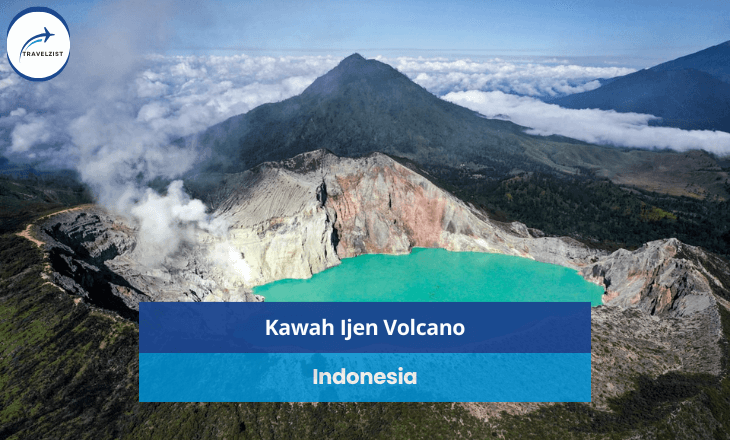Dawn or dusk, the surreal beauty of Kawah Ijen emerges from an otherworldly palette of contrasts — a turquoise lake against grey ash-covered land that flickers with blue fire. Welcome to the mesmerizing world of Ijen in East Java, Indonesia, where nature unveils its wondrous enigma. This article takes you on an unforgettable journey through this volcanic landscape’s mystical aura and geological wonders.
Where Is Kawah Ijen?
Ijen is a beautiful natural wonder in eastern Java, Indonesia. It’s part of an enormous volcano and is famous for its bright blue sulfur lake, one of the most acidic in the world. The lake isn’t the only attraction. At night, the volcano reveals a unique blue fire that can’t be found anywhere else. This blue glow, often mistaken for lava, is burning sulfuric gas. Imagine seeing this fantastic sight under a star-filled sky! It’s an experience to add to your travel list.
How To Get To Ijen
Exploring the enchanting Ijen Crater in Indonesia is a journey worth embarking on. To get to Ijen, you can start your adventure from Banyuwangi, a city located near the eastern tip of Java Island. From there, you can hire a local guide or join an organized tour to take you on a scenic drive towards Mount Ijen.
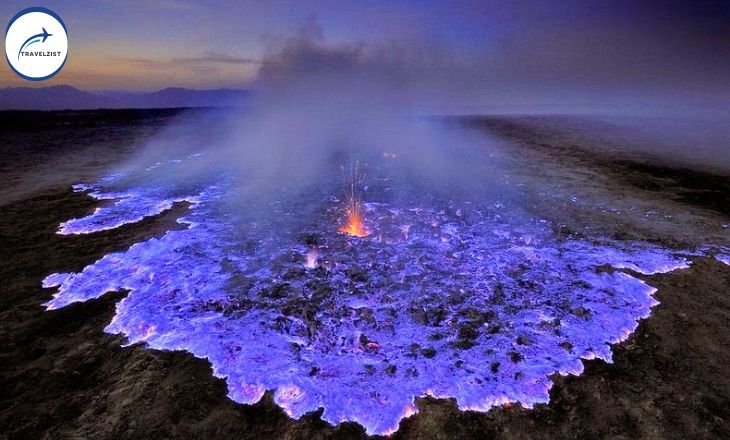
Prepare for a tough hike up to Ijen’s blue flames and acidic lake. The trek will test your strength but the views are worth it. You’ll hike up steep paths early in the morning to see the sunrise. Bring warm clothes and good hiking boots for this challenging but unforgettable experience at Ijen Crater.
Drive To Ijen From Bali
Are you planning a trip from Bali to the stunning sulfuric landscape of Mt Ijen? Let’s make that dream come true. First, brave adventurers may choose an exciting drive across diverse landscapes, covering about 213 km. This thrilling ride usually takes around six hours. The lush scenery and peaceful coastal roads will make your long drive as enjoyable as your destination.
Fly To Banyuwangi
If you value time, the quickest way to reach Banyuwangi, also known as the Sun Rise of Java, is by flight. Flying from Denpasar in Bali takes about an hour to Banyuwangi Airport. It’s just a short two-hour drive from the airport to Mt Ijen. You’ll pass through charming villages and see stunning views on your way. Banyuwangi is a lively city and a great starting point for climbing one of Indonesia’s most exciting volcanoes. Have a safe trip!
Road Trip Across Java
You can explore the Ijen volcano by taking a road trip across East Java. This trip includes stops at popular attractions such as the Mount Bromo sunrise, the Ijen crater, and famous waterfalls like Tumpak Sewu. This is how we first experienced Ijen, and it was memorable.

This type of trip can be costly and time-consuming. Java is a large island with attractions spread out, so you’ll need at least three days for the journey, which may still feel rushed. The good news is that you can start and end your Java road trip in Bali or from a city in Java like Yogyakarta.
Best Mount Ijen Tour Package
Java Adventure Trail offers a top-rated Mount Ijen tour package. This one-day deal includes hotel pick-up and drop-off, a guide, park entry fees, a gas mask and headlamp for the hike, plus breakfast and water. The tour’s main attraction is the stunning blue fire at night, a unique feature of Mount Ijen.
Blue Fire Tours offers an excellent 2-day trip package. This includes a visit to Bromo Mountain. The deal includes transport, a one-night stay, meals, all entry fees, and an English guide. You can explore two famous volcanoes of East Java in one journey.
Ijen Hike – What To Expect
The Ijen Volcano is a popular spot for brave explorers and nature lovers because of its distinct beauty. The famous hike to the top is not easy but exciting and full of surprises. You’ll walk through a thick forest full of different animals. Then, you’ll see a bright blue sulphuric lake that makes the rough volcano look incredibly beautiful.
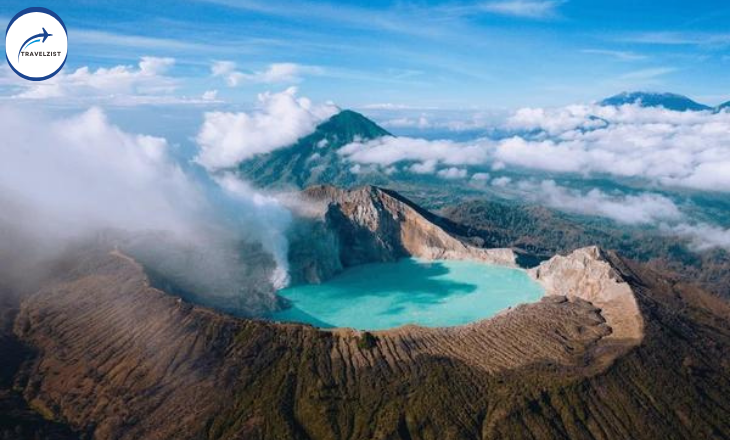
You’ll see a fantastic sight at the top of the hill – blue flames under the stars! These flames come from sulfur gases reacting with oxygen at specific temperatures. You can only see this in two places in the world, including our own Ijen volcano. But wait until sunrise for another surprise – a view that spans across green valleys to faraway mountains, perfect for Instagram photos.
Quick Facts
The round trip is 6 kilometers with an elevation gain of 435 meters. You’ll start at 1,865 meters and end at 2,300 meters. The journey will take 3 to 5 hours and is moderately complex.
Midnight Hike
The Ijen volcano hike starts with a midnight pick-up from a hotel in Banyuwangi. After an hour’s drive, you reach the park entrance. The hike up the mountain is crowded and could be more exciting. The main path is steep and dirty but clear and family-friendly. The hike can be exhausting due to the incline, making it moderate for infrequent hikers. The first 2 kilometers are the steepest, but it gets flatter towards the end. The total distance to the top of the volcano is 3 kilometers, with a height increase of about 435 meters. This doesn’t include the later blue flame section.
Ijen Blue Fire
The Ijen Blue Fire in East Java, Indonesia, is a unique natural wonder. It’s not a regular fire but a bright blue flame that resembles something from a science fiction movie. It’s created by burning sulfuric gases at very high temperatures, up to 600 degrees Celsius, and can be seen clearly at night. This unique and stunning flame is a powerful example of the wild beauty of our planet. If you love adventure and awe-inspiring sights, you should visit Ijen. It’s another reminder that nature’s beauty and drama never stop surprising us.

Ijen Crater Lake
Ijen Crater Lake in Indonesia is a stunning and mysterious sight with turquoise water and sulfur clouds. It’s different from typical volcanic scenery. The lake is the world’s largest acidic lake and turns blue during the day. At night, molten sulfur flowing into the cold water creates a blue fire, making it a unique sight. People call it ‘Blue Fire Crater’. This place offers beautiful views and exciting information about our planet’s formation.
Sulfur Mining At Ijen
Ijen, in East Java, has a particular sulfur mining site on the Ijen volcano. It has been important for Indonesia’s economy for many years. Miners carry over 70 kilos of yellow rocks down the rocky cliffs despite the toxic gases and challenging trails. This job is crucial for medicine, farming, and jobs for local people. Watching the miners on these slopes helps us understand the bond between humans and nature.
Is Mount Ijen Safe?
Exploring the beautiful Mount Ijen in Indonesia is both exciting and risky. This active volcano is known for its blue flames, which are caused by burning sulfur. However, volcanic gases and sudden eruptions can also be dangerous. So, even though it’s a dream for thrill-seekers, it’s important to ask – is Mount Ijen safe?

It would help if you were careful when exploring dangerous places like Mount Ijen, but it can be safe with good planning and safety measures.
Ijen Entrance Fee
The entrance fee for Ijen varies depending on a few factors, including whether you are a domestic or international visitor. As of the latest updates, the entrance fee for international visitors is around 100,000 IDR (Indonesian Rupiah) on weekdays and 150,000 IDR on weekends. For domestic visitors, it is significantly cheaper.
Weather / Climate At Mt Ijen
Mt. Ijen’s weather is unique, offering excitement and peace. It can be freezing in the mornings, often dropping to the low teens, but the afternoons are usually pleasant, staying around 20 C-22 C. The mornings are often foggy, and the evenings end with beautiful sunsets.
What To Bring To Ijen
Pack essentials for the Ijen trip: hiking boots, backpack, headlamp, warm clothes, gas mask, water bottles, camera.
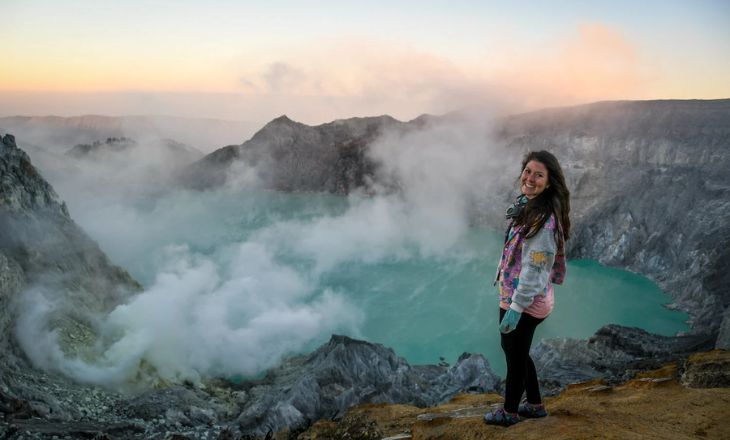
Other Tips For Ijen
Clothes: The sulfur odor is unpleasant and sticks to your clothes, especially if you get close to the blue flame. Avoid wearing nice clothes or jewelry, particularly silver, as the sulfur can tarnish it. Washing and drying your clothes will eventually remove the smell, but it’s best not to avoid wearing anything fancy for this trip.
Bathrooms: The last restroom is at the Ijen entrance. Make sure to use it before you start hiking. There are no proper restrooms on the Ijen trail, but plenty of tall bushes are on the crater lake’s east side for urination.
Cell Service: We had a strong reception with Telkomsel throughout the hike, including exemplary service at the top of the crater lake.
Drones: Currently, there are no restrictions on flying drones at Mount Ijen. The area is spacious enough to pass without disturbing others.
Restaurants: In Banyuwangi, consider visiting Kedai Panorama, Srengenge Wetan, or Company Man Angkringan. They offer tasty food at affordable prices!
Best Time To Visit
Choosing the right time to visit Mountain Ijen is essential for your trip. The best time to go is from July to September. During these months, the weather in Indonesia is usually straightforward and dry, perfect for hiking up to the volcano rim. Remember that the unique view of the blue flames can only be seen properly before dawn or at sunrise. This is when the dark sky reveals the bright flames against a beautiful backdrop. It’s a view you should take notice of!

Is Mount Ijen Open / Closed?
Like other tourist spots, Mount Ijen’s status can change due to weather, volcanic activity, and local rules. Right now, there’s no news that Mount Ijen is closed. But it’s good to ask local authorities or tour guides for the latest updates. Remember, Mount Ijen can be dangerous even when it’s open because it’s an active volcano. The walk to the crater is challenging, and there’s often a lot of sulfuric gas near the crater lake, which can be harmful. So, you should prepare well and take safety steps when planning a visit.
More Things To See Near Ijen
The Jagir waterfall, close to the Ijen Crater, is a beautiful spot for nature lovers and adventurers. Its calming waterfall contrasts with the acidic kawah ijen lake. Away from the busy cities, you can visit the Coffee Plantation Village. Here, you can enjoy the smell of fresh coffee beans grown in Bali’s volcanic soil. You can also learn about traditional coffee-making methods and enjoy the view of the green landscape. The areas near Ijen offer a mix of stunning landscapes and rich cultural experiences.
Kawah Ijen Volcano Vs Crystal Bay Nusa Penida
The contrast between Kawah Ijen Volcano and Crystal Bay Nusa Penida is like stepping into two different worlds within the realm of natural wonders. Kawah Ijen mesmerizes with its otherworldly blue flames dancing in the darkness, a volcanic phenomenon rarely witnessed elsewhere. The surreal landscape of the crater lake, with its acidic turquoise waters and sulfuric fumes, portrays an eerie beauty that captivates adventurers.
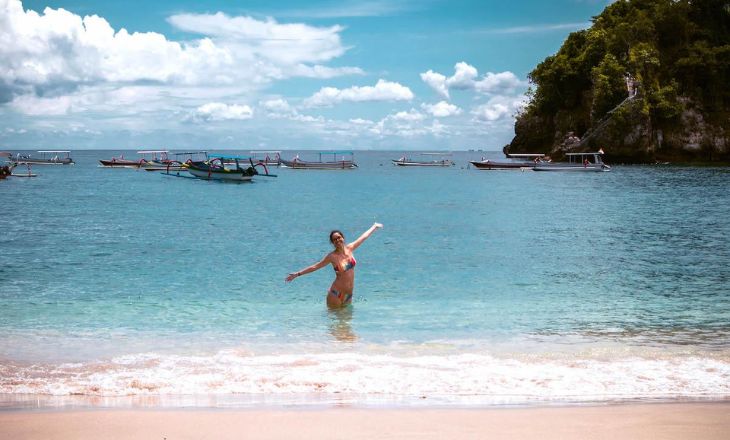
In stark contrast, Crystal Bay in Nusa Penida beckons visitors with its pristine white sandy beach and crystal-clear waters teeming with vibrant marine life. Snorkeling or diving in these azure depths offers a glimpse into an underwater paradise which feels a world away from the rugged volcanic terrain of Kawah Ijen. The peaceful tranquility of Crystal Bay juxtaposed against the raw power and mystique of Kawah Ijen creates a fascinating duality that appeals to travelers seeking diverse natural experiences.
Conclusion
The Kawah Ijen Volcano is a landmark and a stunning display of color, elements, and geological wonders. Its beautiful turquoise lake and captivating blue fire make it unique among volcanoes worldwide. The sulfur mining here shows human strength in harsh conditions. But it’s important to follow local guides’ advice and safety rules because it can be dangerous. Seeing the beauty of Mount Ijen is a must-do adventure for all explorers.
FAQs
Why Does The Kawah Ijen Volcano Have Blue Lava?
The Ijen volcano in Indonesia doesn’t have blue lava. Instead, it contains a lot of sulfur. When these sulfuric gases touch air hotter than 360 C, they light up, creating blue-looking flames. The sulfuric gases also turn into liquid sulfur, a spooky blue color. These blue flames and liquid sulfur make it look like blue lava is flowing down the volcano.
When Was The Last Eruption Of The Ijen Volcano?
The Ijen volcano in Indonesia is still active, even though its last big eruption was in 1817. It regularly releases sulfuric gases. This constant activity has made the world’s largest extremely acidic lake at the top of the mountain. Small eruptions and earthquakes have existed since 1817, but they weren’t big enough to be called eruptions.
What Is The Closest City To Ijen Volcano?
Banyuwangi, a city far east of Java Island, Indonesia, is the nearest city to the Ijen volcano. It’s about 35 kilometers away and is the main entry point for tourists visiting the volcano. Banyuwangi provides a range of places to stay and transport choices for those going to Ijen.
- Top 10 Best Places to Visit in New Mexico (With Pictures) - 4 September 2024
- Snakes In Bali: 6 Deadly & Venomous Bali Snakes - 17 August 2024
- 15 Best Temples In Bali Indonesia: An Ultimate Guide: - 28 May 2024

